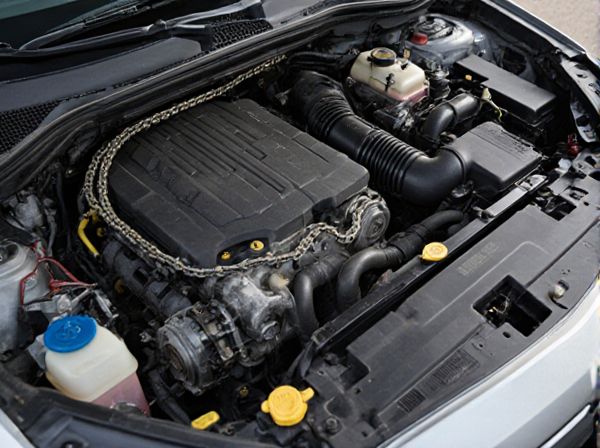
Photo illustration: Timing Belt vs Timing Chain
Timing belts and timing chains both synchronize the engine's camshaft and crankshaft to ensure precise valve operation, but timing belts are typically made of rubber and require periodic replacement, while timing chains are metal and generally last longer with less maintenance. Your choice between the two affects engine noise, durability, and long-term maintenance costs, with timing chains often favored in modern vehicles for their robustness. Proper understanding of these components is essential for optimizing engine performance and reliability.
Table of Comparison
| Feature | Timing Belt | Timing Chain |
|---|---|---|
| Material | Rubber with fiberglass or Kevlar reinforcement | Metal alloy chain |
| Durability | Generally 60,000 to 100,000 miles | Typically lasts over 150,000 miles |
| Maintenance | Requires regular replacement | Minimal maintenance, usually replaces with engine overhaul |
| Noise | Quieter operation | Louder, metallic sound |
| Cost | Lower initial cost, higher lifespan maintenance cost | Higher initial cost, lower maintenance cost over time |
| Failure Risk | Potential for catastrophic engine damage on failure | Less likely to cause immediate engine damage |
Introduction to Timing Belts and Timing Chains
Timing belts are toothed rubber belts that synchronize the rotation of the crankshaft and camshaft, ensuring precise engine valve timing. Timing chains, made of metal links, perform the same function but offer greater durability and longevity under higher stress conditions. Both components are critical in preventing engine misfires and maintaining optimal performance in internal combustion engines.
Key Differences Between Timing Belts and Chains
Timing belts are made of reinforced rubber and require replacement every 60,000 to 100,000 miles, while timing chains are metal and generally last the lifetime of the engine. Timing belts run more quietly and are lighter, but timing chains offer greater durability and better resistance to heat and wear. Maintenance costs for timing belts tend to be higher due to regular replacements, whereas timing chains may need tensioner adjustments or replacements less frequently.
Materials and Construction
Timing belts are typically made from high-strength rubber composite materials reinforced with fiberglass or Kevlar fibers, offering flexibility and quieter operation. Timing chains consist of metal links crafted from hardened steel, providing superior durability and resistance to wear under high-stress conditions. The construction of timing belts involves a toothed belt design, while timing chains use interlocking metal links, influencing their maintenance intervals and longevity in engine applications.
Performance and Efficiency
Timing belts offer quieter operation and lighter weight, contributing to improved engine efficiency and smoother performance, especially in smaller, high-revving engines. Timing chains provide greater durability and require less frequent replacement, which enhances long-term performance reliability, particularly in high-torque engines. The choice between belt and chain impacts engine responsiveness and maintenance costs, influencing overall vehicle efficiency and lifespan.
Durability and Longevity
Timing chains are generally more durable and designed to last the lifespan of the engine, often exceeding 150,000 miles without replacement. Timing belts, made from rubber composite materials, typically require replacement every 60,000 to 100,000 miles to prevent failure. The longevity of timing chains makes them preferable for high-mileage vehicles, while timing belts offer quieter operation but necessitate regular maintenance for optimal performance.
Maintenance and Replacement Costs
Timing belts typically require replacement every 60,000 to 100,000 miles, with maintenance costs ranging from $300 to $500 due to labor and part expenses. Timing chains are more durable and often last the lifetime of the vehicle but can incur higher repair costs of $1,000 to $3,000 if replacement is necessary. Regular inspection of timing belts prevents engine damage, while timing chain issues are less frequent but more expensive to fix.
Common Failure Signs
Common failure signs of a timing belt include unusual engine noises such as ticking or rattling, engine misfires, and difficulty starting the vehicle. Timing chain failure often presents as a rattling noise from the front of the engine, engine performance issues, and metal shavings in the oil. Both components require prompt attention upon recognizing symptoms to prevent severe engine damage.
Impact on Engine Performance
Timing belts provide precise synchronization between the crankshaft and camshaft, ensuring optimal valve timing for efficient engine performance and smoother operation. Timing chains, being more durable and less prone to stretching, maintain consistent timing over a longer lifespan, which contributes to sustained engine power and reduced maintenance intervals. Engine performance can degrade with a worn timing belt due to potential slippage, while timing chains help maintain peak performance by preserving accurate valve timing.
Pros and Cons of Timing Belts vs Timing Chains
Timing belts offer quieter operation and cost-effective replacement, but they require regular maintenance typically every 60,000 to 100,000 miles to prevent failure. Timing chains provide greater durability and often last the engine's lifetime with minimal maintenance, though they can be noisier and more expensive to repair if issues arise. Vehicle manufacturers choose timing belts or chains based on factors like engine design, cost, and maintenance preferences.
Choosing the Right Option for Your Vehicle
Choosing the right timing belt or timing chain depends on your vehicle's manufacturer specifications, engine type, and maintenance preferences. Timing belts require regular replacement, typically every 60,000 to 100,000 miles, to prevent engine damage, while timing chains usually last longer, often the lifetime of the engine, but can be noisier and more expensive to repair. Understanding the pros and cons, such as the quieter operation and lower cost of belts versus the durability and lower maintenance of chains, helps ensure optimal engine performance and longevity.
 caratoz.com
caratoz.com